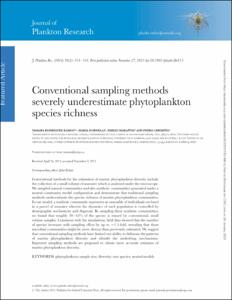| dc.contributor.author | Rodríguez-Ramos, Tamara | |
| dc.contributor.author | Dornelas, María | |
| dc.contributor.author | Marañón, Emilio | |
| dc.contributor.author | Cermeño, Pedro | |
| dc.date.accessioned | 2023-01-24T19:28:29Z | |
| dc.date.available | 2023-01-24T19:28:29Z | |
| dc.date.issued | 2014 | |
| dc.identifier.citation | Rodríguez-Ramos, T., Dornelas, M., Marañón, E. and Cermeño, P. (2014) Conventional sampling methods severely underestimate phytoplankton species richness. Journal of Plankton Research, 36, pp.334-343. DOI: https://doi.org/10.1093/plankt/fbt115 | en_US |
| dc.identifier.uri | https://repository.oceanbestpractices.org/handle/11329/2127 | |
| dc.description.abstract | Conventional methods for the estimation of marine phytoplankton diversity include the collection of a small volume of seawater which is analysed under the microscope. We sampled natural communities and also synthetic communities generated under a neutral community model configuration and demonstrate that traditional sampling methods underestimate the species richness of marine phytoplankton communities. In our model, a synthetic community represents an ensemble of individuals enclosed
in a parcel of seawater wherein the dynamics of each population is controlled by demographic stochasticity and dispersal. By sampling these synthetic communities, we found that roughly 20 –45% of the species is missed by conventional, small volume samples. Consistent with the simulations, field data showed that the number of species increases with sampling effort by up to ~1.5-fold, revealing that these microbial communities might be more diverse than previously estimated. We suggest that conventional sampling methods have limited our ability to delineate the patterns of marine phytoplankton diversity and identify the underlying mechanisms. Improved sampling methods are proposed to obtain more accurate estimates of marine phytoplankton diversity. | en_US |
| dc.language.iso | en | en_US |
| dc.subject.other | Grupo de Oceanografía Biológica, University of Vigo | en_US |
| dc.subject.other | Sample size | en_US |
| dc.subject.other | Rare species | en_US |
| dc.subject.other | Neutral models | en_US |
| dc.subject.other | Phytplankton diversity | en_US |
| dc.title | Conventional sampling methods severely underestimate phytoplankton species richness. | en_US |
| dc.type | Journal Contribution | en_US |
| dc.description.refereed | Refereed | en_US |
| dc.format.pagerange | pp.334-343 | en_US |
| dc.identifier.doi | https://doi.org/10.1093/plankt/fbt115 | |
| dc.subject.parameterDiscipline | Phytoplankton | en_US |
| dc.subject.dmProcesses | Data acquisition | en_US |
| dc.bibliographicCitation.title | Journal of Plankton Research | en_US |
| dc.bibliographicCitation.volume | 36 | en_US |
| dc.description.eov | Phytoplankton biomass and diversity | en_US |
| dc.description.maturitylevel | Mature | en_US |
| dc.description.adoption | International | en_US |
| dc.description.methodologyType | Methodological commentary/perspect | en_US |
| dc.description.methodologyType | Reports with methodological relevance | en_US |
| obps.endorsementAuthorDeclared.recommendedPractice | OSPAR | |
| obps.contact.contactemail | :tamara@uvigo.es | |
| obps.contact.contactorcid | 0000-0002-8766-9991 | |
| obps.resourceurl.publisher | https://academic.oup.com/plankt/article/36/2/334/1501488 | |
 Repository of community practices in Ocean Research, Applications and Data/Information Management
Repository of community practices in Ocean Research, Applications and Data/Information Management
